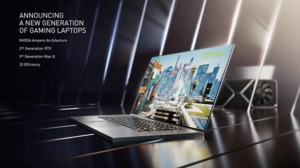Ampere goes into the notebook: NVIDIA unveils new GeForce RTX GPUs
Source: Hardware Luxx added 12th Jan 2021Even in the run-up to CES and even before today’s keynote from NVIDIA, it was clear: There will be a new wave of GPUs for notebooks and the Ampere architecture will be used in the mobile segment convicted. So far, manufacturers have only been allowed to speak of “the next GeForce generation” or something similar.
As part of an event dubbed “Game on”, NVIDIA launched the GeForce RTX – 30 – Series for notebooks now officially presented. All details about the Ampere architecture and the associated functions can be found in the launch article on the desktop models. NVIDIA has doubled the number of processing units per ampere Streaming Multiprocessor (SM) compared to Turing. There are still only four tensor cores per SM, the number of which has now been halved per SM, but which should be at least twice as powerful in the third generation. There is still one RT Core per SM, but here, too, there are some improvements for the second generation.
All of these measures should mean that the new GPUs are much more powerful than their predecessors . NVIDIA showed corresponding benchmarks and game scenes during the presentation.
Let’s take a look at the technical data of the GPUs in the overview:
| Model | Shader units | Boost clock | Storage | TGP |
| GeForce RTX 3080 Max- Q | 6. 144 |
1.245 – 1.710 MHz | 8th / 16 GB GDDR6 | 80 – 150 + W |
| GeForce RTX 3060 Max-Q | 5. 120 | 1. 290 – 1. 620 MHz | 8 GB GDDR6 | 80 – 125 W |
| GeForce RTX 3070 Max-Q | 3. 840 | 1.283 – 1.703 MHz | 6 GB GDDR6 | 60 – 115 W |
For the shader units we carry the FP 32 – arithmetic units. The INT 32 – arithmetic units correspond in number to half of the FP 32 – units of arithmetic.
The mobile GeForce RTX 3080 works with 6. 144 shader units, the desktop version has 8. 704. Depending on the power budget (80 to 150 + W) the GPU works with 1. 245 to 1. 710 MHz. On the desktop are also 10 GB of graphics memory offered. For the mobile variant, depending on the model, there are 8 or 16 GB.
For the GeForce RTX 3070 in the notebook, NVIDIA uses an ampere GPU with 5. 120 shader units. Here the desktop version comes to 5. 888. The memory expansion is identical to 8 GB. Depending on the power budget, there is also a range for the cycle of 1 this time. 290 to 1. 620 MHz. The GeForce RTX 2017 is initially a small mobile offshoot, but it has more shader units than the desktop model. 3. 584 are there and in the notebook 3. 840. On the other hand, the memory expansion in the notebook is only half as large at 6 GB. Depending on the manufacturer’s TGP, the GPU works with a clock rate of 1. 245 to 1. 703 MHz.
NVIDIA has also improved some of the technologies used for use in notebooks. Dynamic Boost allocates the power budget to the processor, the GPU or the GPU memory – depending on where the performance is currently required. The Wisper Mode 2.0 should ensure the quietest possible operation. In addition, NVIDIA supports the interaction with Intel Resizeable BAR, i.e. the more efficient management of the graphics memory.
Notebooks with a mobile version of the GeForce RTX 3060 should from 1. 099 start euro. Those with a GeForce RTX 3070 cost at least 1. 499 Euro and whoever has a GeForce RTX 3080 would like to use in his notebook, he must from 2. 199 put euros on the table. The prices also depend on the rest of the equipment.
GeForce RTX – 30 – Series laptops are available from 26. January available from various manufacturers. Corresponding announcements can already be found in the notebook news of the last hours and days.
Not only did NVIDIA announce new hardware, but also some other games that should make use of the new hardware . Call of Duty: Warzone and Outriders will support the DLSS and should be able to achieve more FPS. There were also some new announcements for games that support ray tracing effects and DLSS. Among them are Five Nights at Freddys: Security Breach
